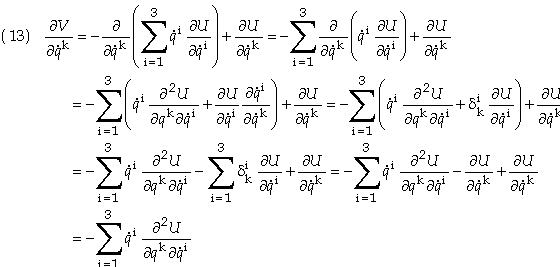
Relativistic Energy
For a relativistic particle the total time derivative of the Lagrangian, L = K - U, is given by

where ![]() and U is a function of position and
velocity and time called the generalized potential. Considerations of
such a potential is required in relativity since it produces velocity dependant forces and
it is well known that all forces in relativity must, in general, be velocity dependant in
an arbitrary frame of reference. However one can choose a particular frame to work in such
that the force does not depend on velocity but only the general case will be considered
here. Using Lagrange’s equations
and U is a function of position and
velocity and time called the generalized potential. Considerations of
such a potential is required in relativity since it produces velocity dependant forces and
it is well known that all forces in relativity must, in general, be velocity dependant in
an arbitrary frame of reference. However one can choose a particular frame to work in such
that the force does not depend on velocity but only the general case will be considered
here. Using Lagrange’s equations

Eq. (1) can be written as

or

Rearranging terms we get
This can be written in terms of the energy function, h, defined as
![]()
Eq. (4) then becomes
![]()
If the Lagrangian, L, is not an explicit function of time then it follows that h = constant, i.e. h is an integral of motion. Substituting L into Eq. (6) gives

where

To evaluate this relation first find the partial derivative of K

Similar expressions hold for the other components. We may now evaluate T to obtain

The second quantity on the right hand side of Eq. (8) is defined as


When U is linear in velocity terms then V will not be a function of the generalized velocities but will at most a function of position and time. V is then referred to as the potential energy of the particle [Ref 4]. In such cases h is the total energy, W, of the particle. I.e.
![]()
If the particle is moving in an electromagnetic field then the Lagrangian is given by
![]()
In this Lagrangian U is given by
![]()
Since U is a linear function of velocity then it follows that the potential energy is well defined and has the value defined by Eq. (12). First find the partial derivative of the generalized potential with respect to the velocity
![]()
Similar expressions hold for the other components. Eq. (12) now becomes

which is the expected result. The total energy of a particle in an EM field is therefore given by
![]()
[1] Classical Mechanics - 3rd Ed., Goldstein, Poole & Safko, Addison Wesley, (2002), page 61, Eq. (2.53)
[2] Ref. 1 page 313 Eq. (7.136)
[3] Classical Electrodynamics - 2nd Ed., J.D. Jackson, John Wiley & Sons, (1975), page 574 Eq. (12.9)
[4] The Variational Principles of Mechanics – 4th Ed., Lanczos, Dover Pub., (1970), page 33, Eq. (18.5)